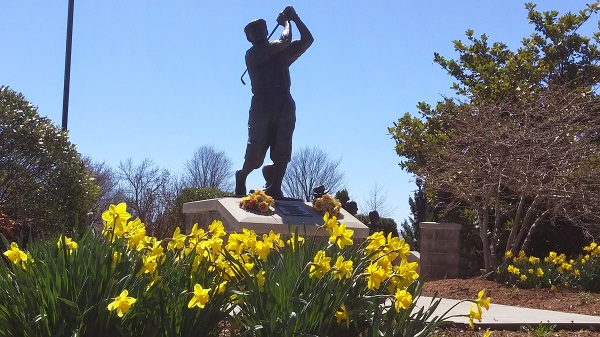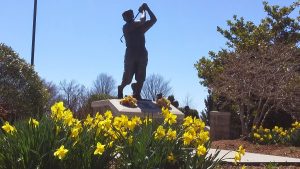
It rises toward the summer’s cotton-candy blue sky as a tribute to the Ozarks’ native golf son, and a gasp is said to have gone up as bystanders take a closer look.
See the Tam o’shanter hat and the baggy knickerbockers? And check out the classic finish of his tee shot – a picture-perfect pause, with the right elbow down and a baseball grip, golf club angled behind his left shoulder, right shoe on its tip.
Meet the larger-than-life-size bronze of the late Payne Stewart on the Legends Walkway outside the Missouri Sports Hall of Fame — and also one of the Hall’s neat, untold stories.
You see, this is sacred ground – literally.
Stewart’s ashes are here, even unbeknownst to its sculptor.
Some were scattered around the statue after its dedication on Aug. 12, 2000, less than a year after Stewart’s tragic plane accident.
And now, with the anniversaries of Stewart’s two U.S. Open victories upon us this week, family as well as the Hall’s longtime President and Executive Director, Jerald Andrews, cannot help but reflect.
In fact, one of Payne’s sisters spread the ashes during the ceremony, although time understandably may have led some in attendance to forget.
“He needed to be there,” Lora Stewart Thomas explained. “It was part of him and part of our dedication of the statue to be there also.”
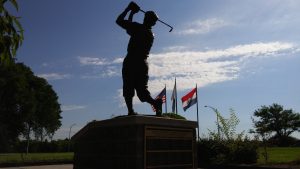
In his tucked-away, second-floor office recently, Andrews sat comfortably in the executive director’s desk chair and recalled the ceremony well. He was six years into his term here.
Andrews named notable leaders in attendance that day, and was spot on: founder John Q. Hammons, then-Hall Chairman Joe Greene, then-Missouri Lt. Gov. Roger Wilson, Buy.com Tour vice president Mike Stevens, longtime friend Jim Morris and sculptor Harry Weber. A story that later appeared in the Hall of Famer magazine carried those names.
Andrews distinctly remembers Stewart’s ashes being spread across the Hall’s east lawn, around the statue. He green-lighted the idea.
“I was a little bit overwhelmed initially that they would choose this location,” Andrews said, recalling when Thomas approached him of the idea. “Yet as I paused to think about it, I couldn’t think of anything better. At the time, there weren’t many bronze statues out here, maybe two or three of the head-and-shoulders but that’s it.
“I knew it’d be a very significant location to remember Payne Stewart.”
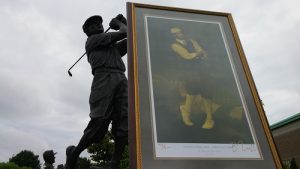
Reached in June 2015, Weber had no idea.
“I remember his mother and sisters being there, but I don’t remember there being any ashes. You’d remember something like that,” a surprised Weber said.
Initially, Weber used a carving knife on a clay mold on the kitchen table at the home of Bee Payne-Stewart, Payne’s mother, with Thomas and Payne’s other sister, Susan Daniels, weighing in. He then finished the statue at his then-Bowling Green, Mo., home, and eventually delivered a memorable line at the ceremony.
“I hope this statue does Payne justice,” Weber said at the ceremony, “but I think Payne built his own monument with all of those who loved him.”
Stewart grew up here in Springfield, mentoring under his dad, 1955 U.S. Open competitor Bill Stewart, at Hickory Hills Country Club.
We loved him because of his Tam o’shanter caps, patterned pants and knickerbockers that revived the game’s bygone era, and we loved him for his WWJD bracelet (What Would Jesus Do?), for his kindness to others and for his passion for game – especially for the USA in the Ryder Cup.
Few probably know that it was Stewart who, on the eve of a Ryder Cup showdown between the U.S. and Britain, fired off this great one-liner: “They ought to be caddying for us.”
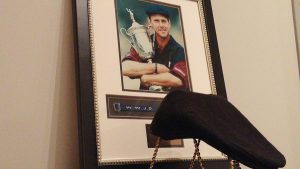
Naturally, his stature only grew in the Ozarks.
Eventually, there was a statue.
The bronze idea had been kicked around several years earlier, but Stewart’s unfortunate accident in October 1999 hastened the effort. Less than three months later, the Hall of Fame’s Board of Trustees approved the plan to raise funds to construct the statue.
It led to a $175,000 fundraiser led by Andrews. A painting of Stewart, unrelated to the statue, later auctioned off for an impressive sum of $22,000.
Look closely at the bronze club in his hands as well as the back right pocket.
The club was none other than Stewart’s seven iron, borrowed by Weber to make the clay mold.
On the notepad protector for Stewart’s scoreboard, which is in his back right pocket, it reads “Chelsea Stewart 11/13/85” and “William Aaron Stewart 4/2/89” in honor of his children.
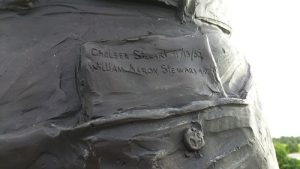
“It was a heck of a lot of fun to do,” Weber said recently. “It was in making that statue that I started to play golf. I felt, before, that playing would be as much fun as a cheese-grader rolled on your head. But Payne Stewart started me on my golf career. I’ve won the St. Louis Senior Olympics a couple of times.”
Now the anniversaries of Stewart’s U.S. Open victories are upon us. They are Wednesday and Saturday of this week, to be exact.
The kids were actually on site 24 years ago when Payne won his first U.S. Open on June 17, 1991. Payne captured the victory in an 18-hole Monday playoff against Scott Simpson at the Hazeltine National Golf Course in Minnesota, rallying from two shots back the final two holes.
The clinching shot? It was a 20-foot birdie putt on 18.
Several years later, on June 20, 1999, he won his second major, the U.S. Open, at Pinehurst Resort in North Carolina by holing a 15-foot par putt to beat Phil Mickelson by a stroke.
Call it vintage Payne, who had a flair for the dramatic. He won his first major in 1989, the PGA Championship, by rallying from six strokes back. It’s 26th anniversary is this August.
His widow, Tracey, still recalls the first one.
“I followed him around the first nine on Sunday and then had to go to the nursery to pick up Chelsea,” Tracey said. “It was pretty exciting. I was sitting with Maria Floyd, and Raymond (Floyd) was the Ryder Cup captain and were thinking he’d make the Ryder Cup team. With every birdie, his chances were very, very exciting. Payne was already in the lead in points, so it gave Raymond an extra pick because the PGA champion was (automatically) on the team back then.”
Tracey later added this: “All of (Payne’s victories) were exciting and special. And anytime you can win a major, it’s pretty good.”
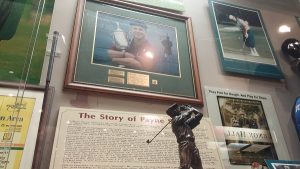
Stewart played for five U.S. Ryder Cup teams, won three “Skins Games” and had seven international victories. He was inducted into the Missouri Sports Hall of Fame in 1994 and named a Missouri Sports Legend in February 2000.
Soon, his statue graced the Legends Walkway – along with some of his ashes.
“The statue will serve as a way for the Hall of Fame to recognize Payne Stewart in a perpetual fashion,” Andrews said during the ceremony, “that will allow the memories of his life and career to influence all who visit and witness the memorial.”
